South Vietnam, Five Year Plan for Agricultural Development, March 26th, 1973, Michel Nr. SVN 526-528; Three stamps in nominals of 2D, 5D and 10D were issued in perforation 12.5:12 (Michel Nr. 526-527) and 11 (Michel Nr. 528). According to eyewitnesses the 10D stamp was a very late addition to the printing order that was directly requested, last minute, by Nguyễn Văn Thiệu as he wanted to use it in order to assist in his public relation campaign to get re-elected. The Japanese foreign printing company that was already executing the printing of the 2 and 5D values indicated that it would be unable to print the 10D in time for issuance so a separate order was given to another printing company in Hong Kong that was able to print the 10D stamp (SICP Journal Volume XII, Nr. 2 from March 1982). As a result the 10D stamp was printed on very different, thicker, paper and with a different perforation. No imperforate trial proofs or Enpreuve de Luxe of the value were produced for the 10D value.
Here is the mint set.
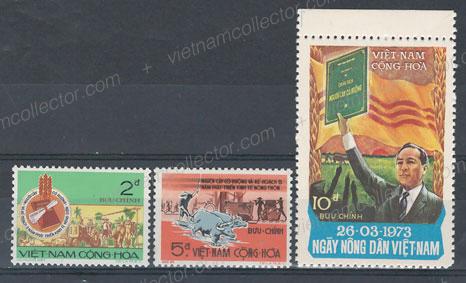
These stamps were not officially released imperforate, however, on the 2D and 5D value imperforate trial proofs have come to market. No imperforate stamps were ever released for the 10D value.
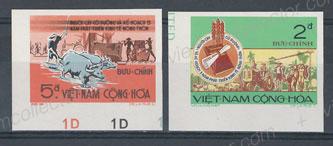
Enpreuve de Luxe of the 2D and 5D values printed on cardboard paper. No Enpreuve de Luxewas produced for the 10D value.
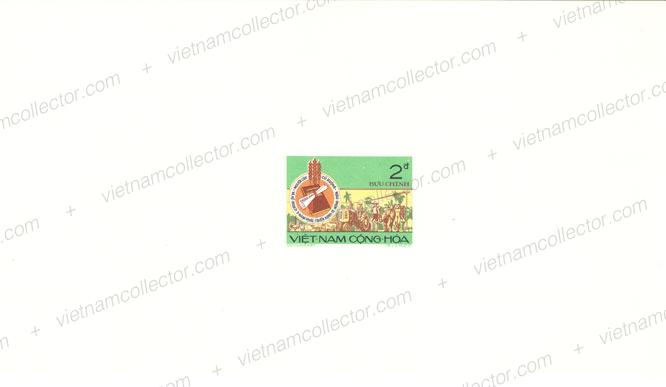
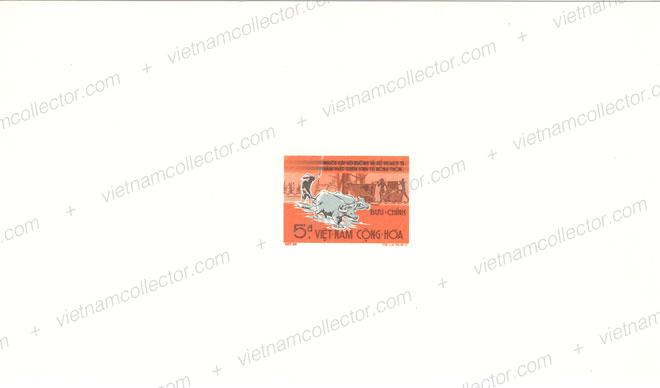
In I977, late SICP member Joe Cartafalsa reported on the scarcity of the top value of the 3rd Anniversary of the Agrarian Reform Law issue (Scott Nr. 450, ICPS Journal 24, July 1977). Joe mentioned that shortly after the fall of Saigon, he had been to Saigon and that, at that time, he was able to purchase a mint copy of the stamp at 90 times its face value from a dealer. He reported that, according to his sources, the stamp was not available from the post office, but could only be procured from dealers. Joe also mentioned that the stamp was first noticed on official First Day Covers, and that no one had seen it used on a commercial cover.
After reading his article, the editor was intrigued. What was up with this stamp? Had it been prepared for issue, and was it withdrawn prior to its release? Was the depiction of President Thieu not pleasing enough, and for that reason another stamp of almost identical design was issued one year later (Michel Nr. 553/SVN Scott Nr. 475)? This would explain why stamp subscription services had delivered the 2 and 5 Dong value of the set, but not the 10 Dong value. Was the 10 Dong value only released after the end of the war, when the Government of Vietnam, hungry for foreign currency, emptied out the postal archives and sold sheets of previously un-issued stamps to collectors? Was this the reason no commercially used copies or commercial covers with the stamp had been found?
Last year, the editor met with fellow SICP member Lucian Lu, and, of course, talked shop. Since Lucian had lived in Saigon at the time the stamp was issued, the editor asked him what he knew about it. Lucian confirmed what Joe had reported, pertaining to the number of stamps printed. Only 1,800 sheets with a total of 45,000 stamps were printed. 10,000 of these stamps were withheld by the post office for the use in FDCs and other commemorative booklets. So only 35,000 stamps were available to the general public on the date of issue. This compares to other sets of South Vietnam of the same time period, of which usually 1 million copies were produced! Due to the scarcity of the stamp, the post office limited the sale of the stamp to a maximum of 4 copies per customer. Lucian, who was a part-time stamp dealer at the time, and wanted to supply his customers, resorted to his entire family lining up with him at the post office so that he could buy the stamp in sufficient quantities. Needless to say, the stamp sold out very quickly.
Virtually all available copies must have been sold to collectors and dealers through the philatelic section of the Saigon General Post Office. Given the scarcity of the stamp, late comers had to pay a substantial surcharge to obtain a mint copy from dealers and those lucky few were not in a great hurry to acually use this rare stamp on a commercial cover, where it might be lost or damaged in the process. This explains why, to date, the stamp has rarely been seen used on a regular piece of mail processed by the post office. The editor has checked E-Bay auction sites and other collector websites for this stamp, on commercially used cover or simply used with a regular date canceler, but in over 20 years he has come up empty-handed. The only used copies one can find are those that were taken off the official FDCs and these, of course, just carry the commemorative first day cancel.
Last year, the author purchased a South Vietnam cover collection, that in large part came from well-known philatelist and former SICP member, the late Theo Klewitz. In it was a commercial cover that included two samples of Scott Nr. 450! The cover is addressed to Klewitz and on the face of it, it looks like an over-franked, philatelic cover. However, upon closer examination one will find that the amount paid was, in fact, what the postal tariff at that time required. To date, this is the only one of two commercial covers that the author has ever seen. The cover below is the only one that carries two of the 10D stamps. The cover was mailed on March 20, 1975, only a few days prior to the fall of Saigon. Klewitz was a keen philatelist and he had an excellent sense for the unusual and rare. It must have been with these thoughts in mind that he initiated a cover to be mailed back to him by his local stamp contact; what was a fairly rare mint stamp on this cover and exposed it to the vagaries of international postal travel. The cover did indeed travel through the mail as can be seen by the red Post Office 6A Fulda arrival stamp.
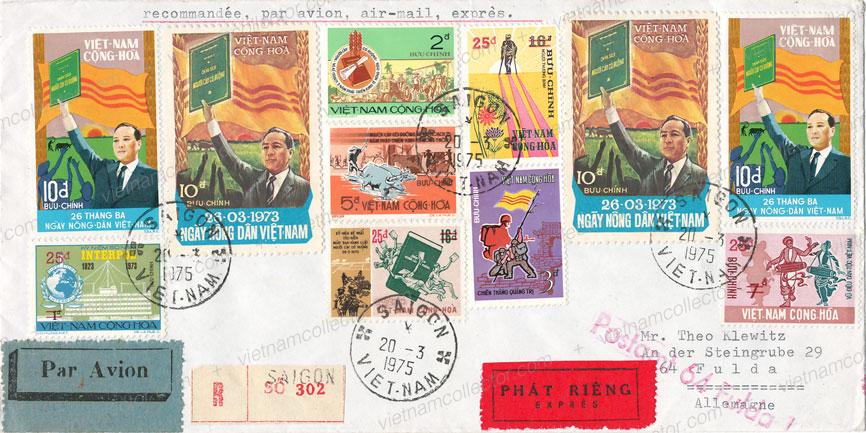
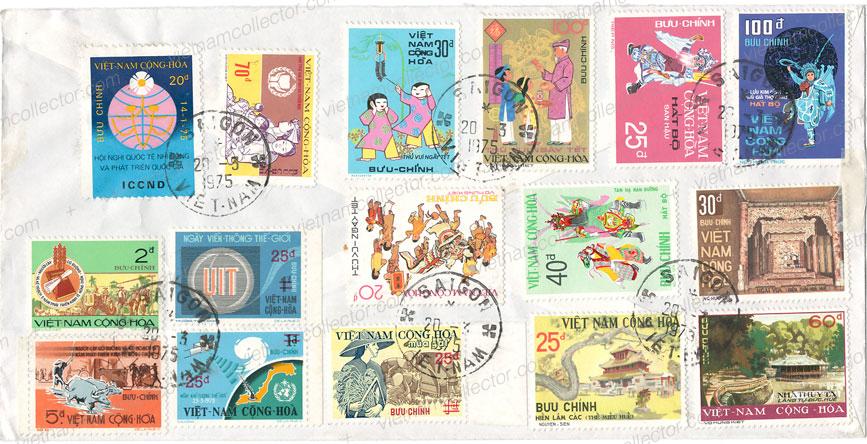
Today, Scott 450 in mint condition is still sought after, but it is widely available for under $5. Multiples of the stamp are harder to find, since the largest quantity sold over the counter were 4 copies per customer. This means a block of 4 that was not separated after purchase is simply rarer; and hence, commands a premium. Nevertheless, a block of four can usually be purchaed for under $30. The story changes quite a bit for complete sheets of 25. Given the circumstances under which the stamp was sold, no one should have been able to buy an entire sheet. Complete sheets, therefore, were either obtained by bribing the postal clerks in Saigon, or they were obtained from the postal archives after the fall of Saigon. This would explain Joe‘s report that complete sheets were available from dealers. Today, they rarely come up for sale as most of them have been seperated into smaller units. If you can get one for under $300, consider yourself lucky.
Complete sheet of the 10D value with all margins intact and original gum. For technical reasons only scanned partially
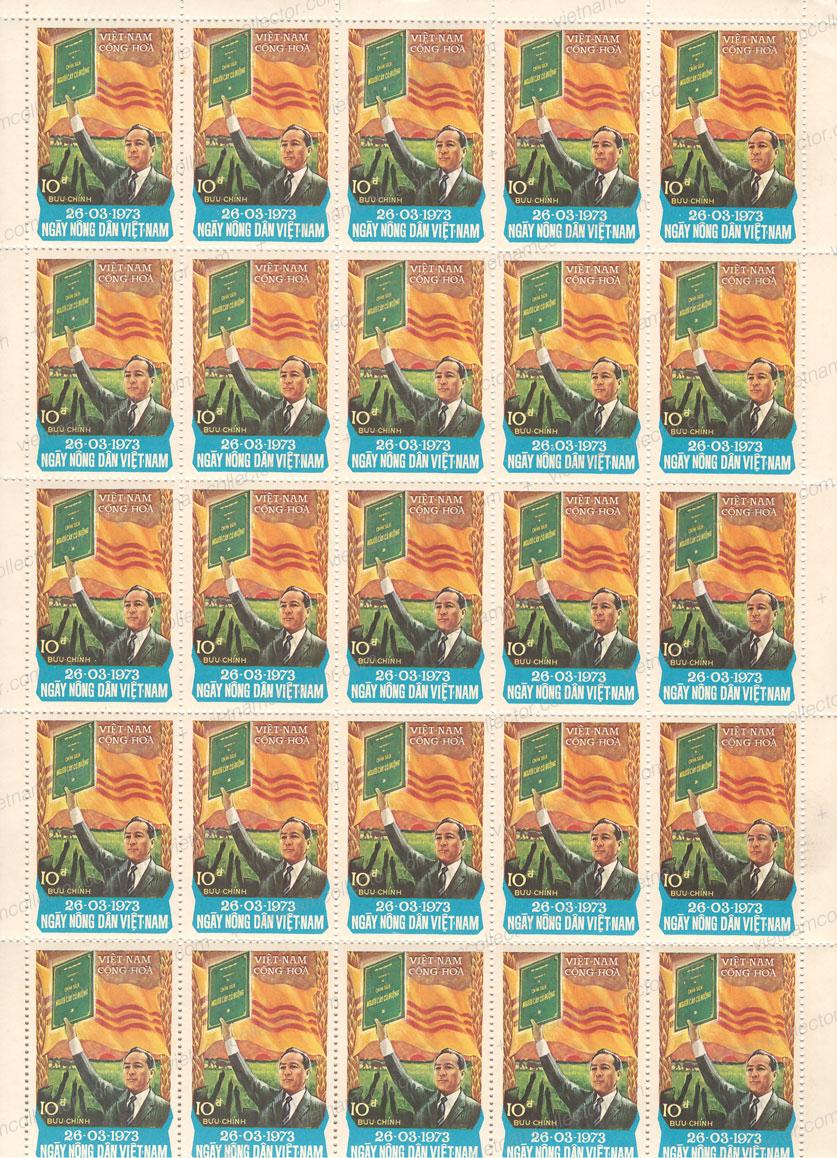
FDCs of Scott Nr. 450 and loose stamps obtained from FDCs are quite numerous, as a large number was produced for philatelists and they can be bought for under $5.
First Day Cover
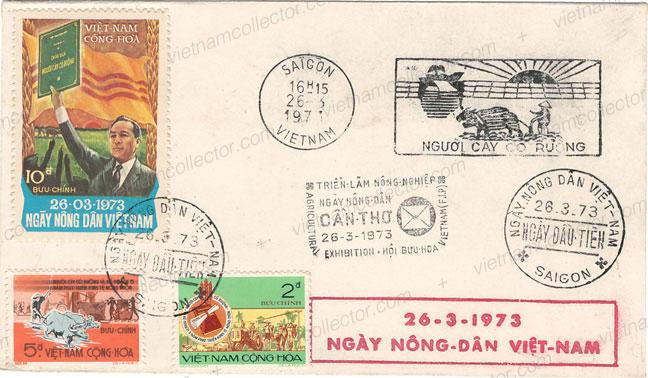
A genuinely loose used stamp with a commercial cancel is so far unknown to the author, but he would gladly pay $100 for a stamp with a legible commercial cancel date prior to April 30, 1975. The cover depicted in this article is most likely one of a very small number in existence. Even the fabled „Blue Mauritius“ that retails at over $1.5 million on cover, is known to exist on multiple covers! Lucian remembers that he sent one cover with the stamp to a customer in Japan but that cover was cancelled with the First Day Cancel. The author would be very keen to learn from fellow collectors who may have this stamp commercially used or o a commercial cover. Please send your comments under the dialogue option of this website.
Mixed franking of the 2D value (3) together with the 3D Rural Development stamp paying an overall postage of 9D on a domestic letter sent from Kim And to Saigon in December of 1973.
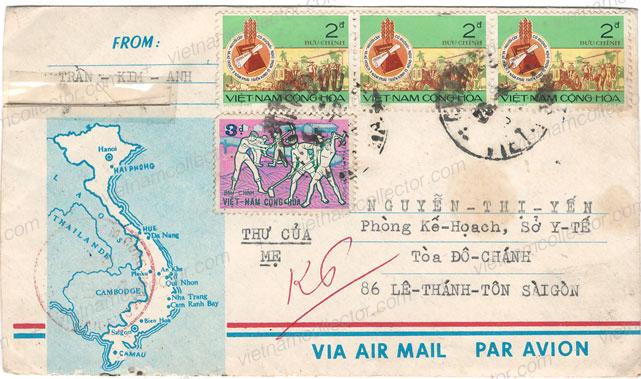
Mixed franking of the 2D Agricultural Development stamps (2) together with the 3D Development of Country stamp paying an overall postage of 7D using the 50% discounted military tariff on a letter sent by a member of the military (KBC 3340/7th Battalion “Killer (Grey) Tigers” located in Rung Cam) to a civilian in Sa Dec. The 7D postage was deficient as the military rate already amounted to 10D at the time and as a result a manuscript “T” was added to the envelope. It is unclear if the additional postage was ever collected. The stamps are attached to the envelope in a “stair” fashion which was a fraudulent attempted use of already used stamps. Black circular KBC seal on front. Rare hexagonal rural transit cancel of Duc-Th??/Sadec from January of 1974 on front.
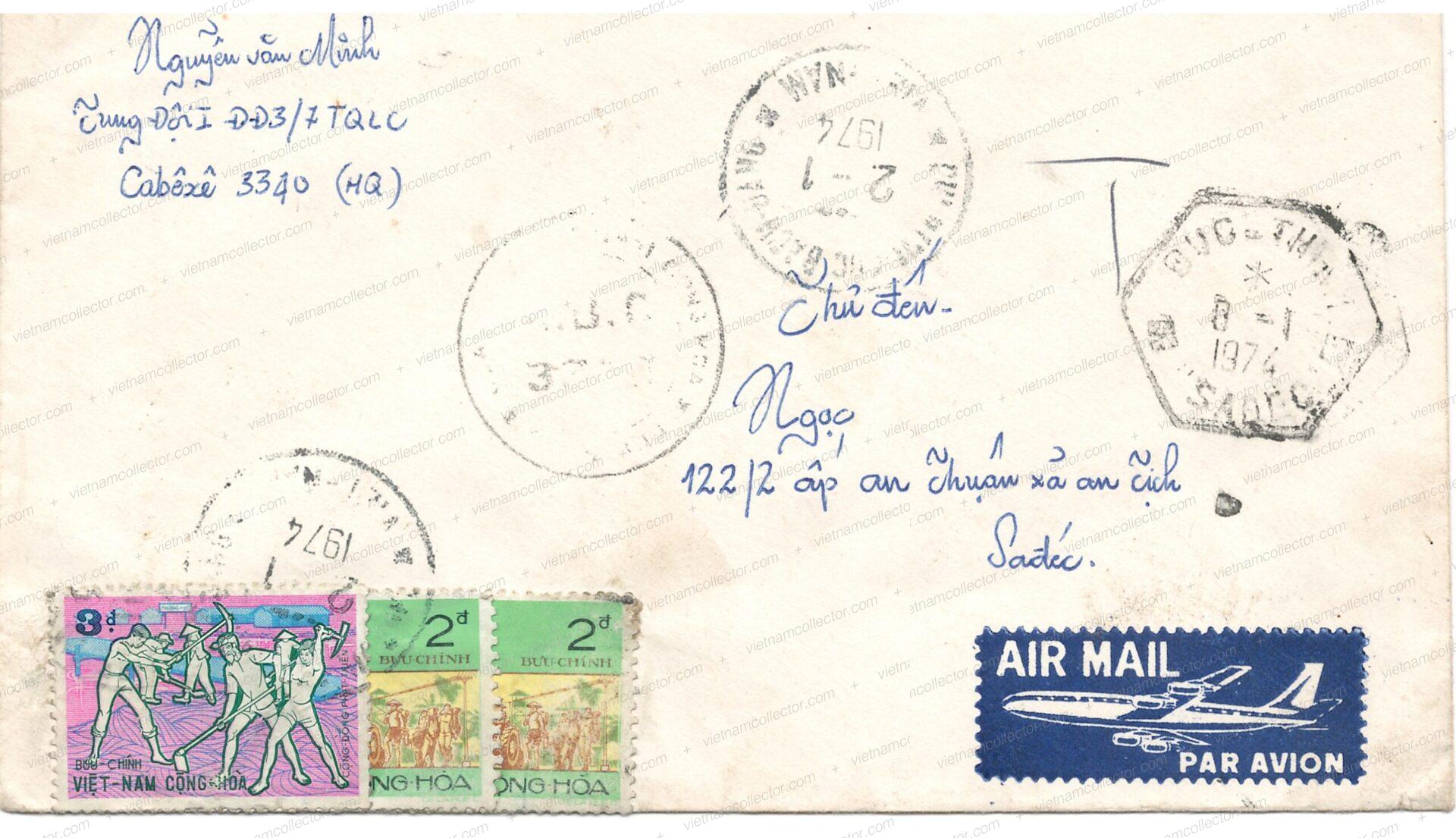
Single franking of the 5D value on a rare printed matter mailing by a medical company sent from Saigon to Vinh Binh.
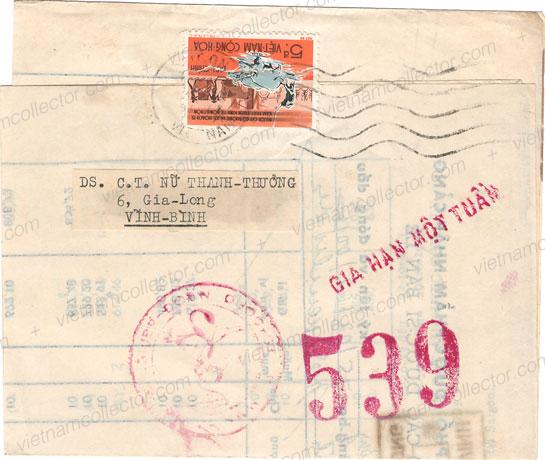
Multiple franking of the 5D value (2) paying a total postage of 10D on a domestic letter sent from Saigon-Cholon (rural cancel) to Kien Phong in September of 1973.
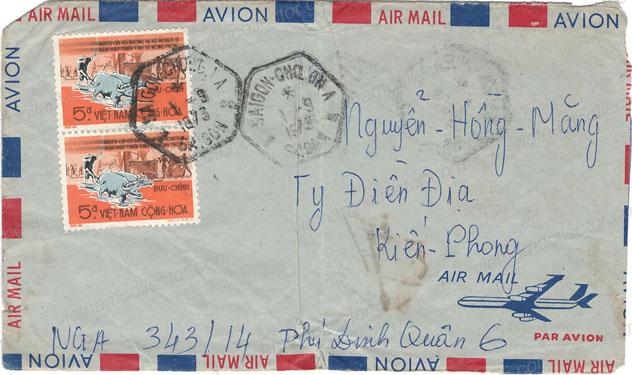
Multiple franking of the 5D value (3) paying an overall postage of 15D on a domestic letter sent from Binh Ding to Saigon in January of 1974.
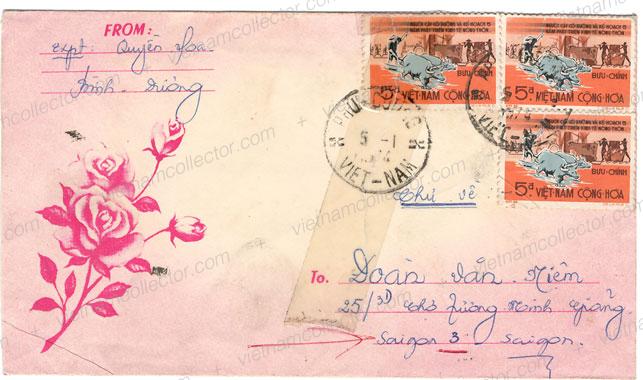
Registation Nr. 201280

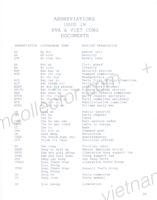
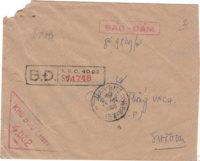
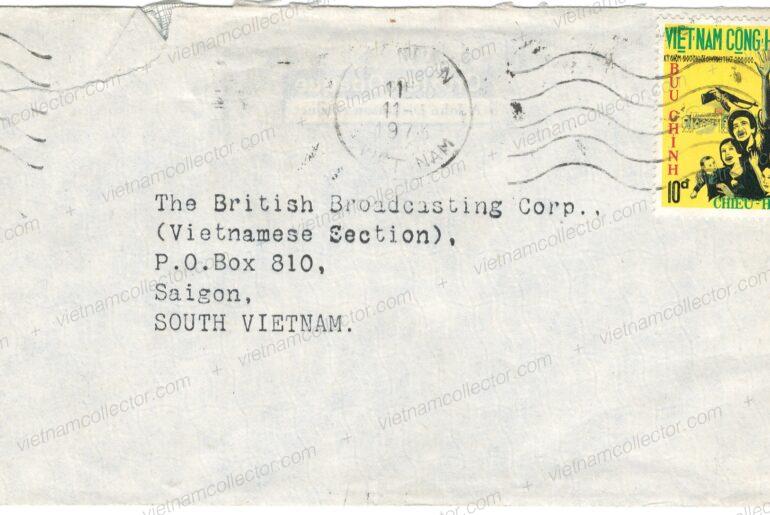
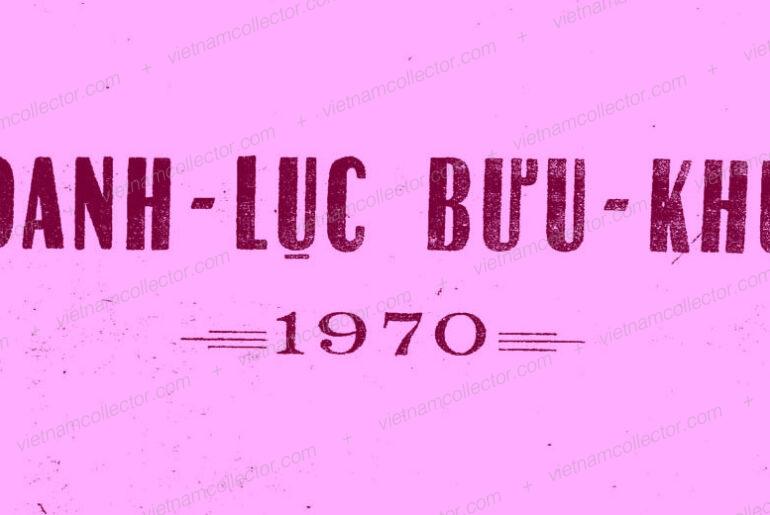
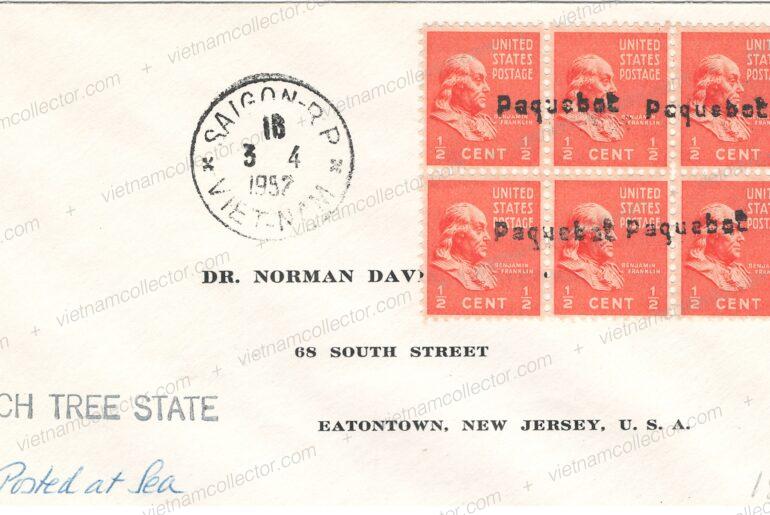
Comments are closed.